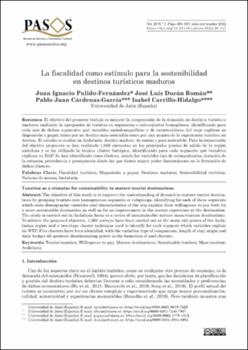La fiscalidad como estímulo para la sostenibilidad en destinos turísticos maduros
Fecha
2022Resumen
El objetivo del presente trabajo es mejorar la comprensión de la demanda en destinos turísticos
maduros mediante la agrupación de turistas en segmentos o subconjuntos homogéneos, identificando para
cada uno de dichos segmentos qué variables sociodemográficas y de características del viaje explican su
disposición a pagar, tanto por un destino más sostenible como por una mejora de la experiencia turística en
destino. El estudio se realiza en Andalucía: destino maduro, de masas y poco sostenible. Para la consecución
del objetivo propuesto se han realizado 1.068 encuestas en los principales puntos de salida de la región
andaluza y se ha utilizado la técnica clúster bietápica, identificando para cada segmento qué variables
explican su DAP. Se han identificado cinco clústers, siendo las variables tipo de acompañantes, duración de
la estancia, procedencia y presupuesto diario las que tienen mayor poder discriminante en la formación de
dichos clústers. The objective of this study is to improve the understanding of demand in mature tourist destina‐
tions by grouping tourists into homogeneous segments or subgroups, identifying for each of these segments
which socio‐demographic variables and characteristics of the trip explain their willingness to pay both for
a more sustainable destination as well as for an improvement in the tourist experience at the destination.
The study is carried out in Andalusia home to a series of unsustainable mature mass‐tourism destinations.
To achieve the proposed objective, 1,068 surveys have been carried out at the main exit points of the Anda‐
lusian region and a two‐stage cluster technique used to identify for each segment which variables explain
its WTP. Five clusters have been identified, with the variables type of companions, length of stay, origin and
daily budget ofe greatest discriminating power in the formation of said clusters.





